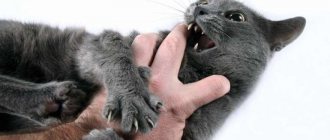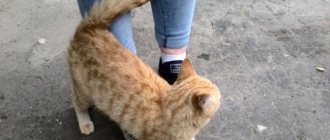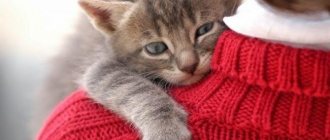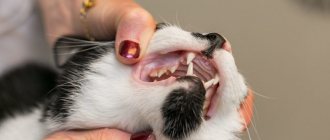Cats by nature are obstinate and independent creatures. They can bite and scratch, showing their instincts. In the article we will talk about the signs of cat aggression, the reasons why a domestic cat bites, and how an owner can understand readiness for an attack. In the material you will also learn how to wean an adult cat and kitten from biting and what not to do in the process of raising a pet.
Cats bite for different reasons and it's not always aggression.
Features of the manifestation of cat aggression
The reasons for a cat's bad behavior lie in its psychology. As a rule, most cats are not prone to unmotivated aggression.
A mentally healthy animal never attacks, scratches or bites for no reason. Most often there is some external irritant.
The most common causes of aggression in cats include the following:
- defending oneself or one's territory;
- sexual arousal;
- pain.
Kittens that have been abused may also exhibit aggressive behavior.
Domestic cats are generally not aggressive
The owner should understand the reasons for the animal’s anger. If a cat is constantly under stress, over time its psyche will become unstable, and it will truly become inadequate.
Sexual hunting
Puberty in cats of popular breeds occurs at the age of 6–9 months. Hormonal surges sometimes make the animal unrecognizable. The cat yells all day, doesn’t sleep, marks its territory, and becomes aggressive. The cat does not leave a single step from the owner, constantly rubs against the legs, caresses due to overexcitation, and bites.
If the owner does not plan to breed offspring, then the only option to save the animal from such torment is castration or sterilization. Some owners are hesitant to resort to such drastic measures. Then veterinarians advise giving the pet a separate room during the period of heat, where no one will disturb him or get on his nerves.
Cause of bites
When a cat bites your hand or lunges aggressively, there is no need to punish it. This behavior does not appear without a reason. By scratching its owner, a cat most often expresses its hunting instinct. She may also experience physical or psychological discomfort. Often this behavior is associated with insufficient education.
The hunting instinct is always with the cat
Therefore, before taking measures to help stop an animal from biting and scratching its owner, it is important to find out what caused this behavior.
Playful mood
Cats have a hunting instinct since childhood. When kittens begin to walk on their own, they fuss with each other, try to fight and attack.
The mother cat begins to teach the babies how to hunt. She can bring a caught mouse so that the kittens can hone attack and defense techniques, and by her example she shows how to hunt.
As a result, the play and hunting instincts are mixed. When the baby sees a moving object - both a toy and the owner's limb - he rushes at it and bites it. He has no intention of hurting a person. The pet simply develops the makings of a predator.
Kittens imitate hunting while playing
If the kitten's owner continues to encourage this behavior, then when the pet grows up, it will behave in exactly the same way. And already a big cat is capable of leaving deep scratches and severely biting through the skin. Therefore, kittens should have a variety of toys to imitate hunting with their help.
Disease
By the behavior of a cat, you can understand that something is wrong with your health; after all, cats cannot tell a person what and where it hurts. If a person touches an injured limb, the cat, feeling acute pain, will scream, hiss or bite.
Feline diseases manifest themselves in different ways, and not every one is accompanied by pain. The following symptoms should alert you:
- weakness, lethargy;
- refusal to eat or drink;
- dry nose, maybe at high temperature;
- restless sleep.
Pain may prompt a cat to bite
Overexcitement
Puberty in cats and female cats occurs at the age of 6–9 months. Animals can become unrecognizable due to hormonal surges. Screaming all day, not sleeping, marking territory is the norm for them during this period. Cats do not leave their owner's side, constantly rub against their legs, caress due to overexcitation and bite.
An owner who does not plan to breed offspring can save the animal from such torment - castrate or sterilize. Some owners are hesitant to resort to such drastic measures. Then veterinarians advise giving the pet a separate room during the period of heat, where no one will disturb him or get on his nerves.
Cats bite during hormonal surges
Expression of love
Cat bites can be seen as a way of communication. If a pet often bites its owner, perhaps this is his way of expressing immeasurable love and devotion. If you scratch a cat's neck or behind the ear, it will definitely turn around to bite the person's hand. However, this bite does not cause pain, but is more like a tingling sensation. But when emotions run high, the biting becomes more intense.
Cats can gently bite their owners
Irritation
Cats bite when they get tired of their owner's intrusiveness. They may twitch their tail nervously, press their ears to their head, and puff up their fur. If a person still does not understand the hints, teeth are used. To avoid such injuries, cat owners should learn to recognize the obvious warning signs.
Teething
The kitten may bite its owner when it is teething. In such situations, the baby constantly tries to put something in his mouth, which is quite normal for this age. To prevent a kitten from growing into a naughty prankster, it is important to explain from an early age that this cannot be done.
Kittens are teething, they can “scratch” their gums on human fingers
To help your cat cut teeth faster and stop biting, it is recommended to buy a special rubber toy that your pet can chew on when he wants to “scratch” his gums.
Boredom
Cats may sometimes bite their owners simply because they are bored. Animals attract attention: first they begin to lick their lips, and then, if the owner does not react, they begin to bite. In order for them to stop behaving this way, it is recommended to spend more time with them, playing, talking, or just sitting together in front of the TV.
Cats, just like people, require communication and attention. You should not scold or punish an animal when, after a long separation, it begins to lick and bite. In such situations, it is important to communicate with your four-legged friend so that he understands how dear and loved he is in the family.
Give your cat time to prevent her from biting out of boredom.
Resentment
Sometimes cats can harbor a grudge against their owner; they will always find an opportunity to take revenge. Some spoil things, others make piles and puddles in the wrong places, and still others bite the offender so that he will forever remember that offending a cat is a bad idea.
Stress
Unpleasant events that happened to a cat, which could greatly frighten it, cause stress, and, as a result, its behavior may be inappropriate. Nervous tension in such situations results in different ways. Some refuse to eat, others hide in a secluded place, and others begin to bite their owners, showing by this behavior that they are uncomfortable.
the gray cat aggressive bites the hand
In such situations, it is important to minimize the stress factor. The animal should feel constant support, understanding, love. Communicate with your cat more often, play, walk. As soon as the pet recovers from stress, its behavior will return to the same as before. You just need to wait out this period and do everything to make him feel safe.
Breed Features
There are breeds of cats that are very difficult to wean from aggression. As a rule, such breeds were developed as a result of crossing with wild cats, which by their nature are aggressive and obstinate.
Why does a cat first caress and then bite?
Most often, mustachioed pets bite, if not in play, then during affection. In this case, there is a sharp change in behavior. The caressing cat, who just a minute ago showed no signs of aggression and was happy with everything, suddenly bites into the owner with a death grip. There are 7 reasons for this strange reaction.
Tired of caressing, wants to stop
The simplest explanation is loss of interest. Your pet may simply get tired of the increased attention, which he will immediately communicate with his teeth and clawed paws.
It is quite easy to recognize dissatisfaction in advance. To do this, you need to carefully monitor nonverbal cues. If your cat appears tense, flattens its ears, and wags its tail, then it should be left alone.
INTERESTING!
An excess of emotions requires discharge by tipping the scales in the opposite direction. The closest analogue of aggressive “biting” during affection is laughter through tears.
Doesn't want contact with a person
All animals are very different. Some people like to have their ears scratched, others like their tummy rubbed, and others like neither one nor the other. In the latter case, the pets sit on their laps with great pleasure, “knead the dough” and rub their faces against the owner’s hands, but immediately turn into angry furies if they are touched.
A similar situation arises if the cat just came to warm up. Her aggression is explained by unjustified expectations, because first of all she came to where it was warm, and not to a person.
Ironing in an unpleasant place
Most cats love to be stroked on the head, chest and back, as well as at the base of the tail and neck. They experience completely different feelings in the abdomen and paws. Only a few people allow touching these areas, so don’t be surprised if your pet is no exception.
In addition to hostility, the animal may experience pain. In this case, either too strong and rough movements or an injured area are to blame. If you suspect a pet's health problems, you should see a veterinarian.
The most controversial feeling is caused by tickling. It cannot be called pleasant or painful, because, in fact, it is a reaction to many irritating impulses. Due to the volume of information received, the brain is lost in recognizing signals and turns on a defense mechanism - a bite.
Played out
Sudden playfulness cannot be ruled out. Vigorous kicking of the hind legs during a grab is used for self-defense in the wild. If the owner does not pose a threat to his pet, then such behavior should be understood as a game of wrestling. Kittens have a special love for this kind of entertainment.
I got scared
Whiskered pets are very sensitive to sounds. If a cat has dozed off in your arms while being petted, then a ringing intercom or an accidental fall of a lump of snow on your windowsill can cause her to have an attack of redirected aggression. In this state, the animal attacks not the source of its fear, but the nearest object.
Tries to dominate
Unlike dogs, cats are not used to living according to the laws of the pack. Subordination to humans is alien to them, because they recognize themselves as full-fledged leaders. The exceptions include only the most good-natured breeds, famous for their truly canine devotion.
A dominant cat bites a person to demonstrate control over the process. In this way, he shows that he is ready to give and receive affection only according to his mood, that is, he behaves like a real alpha male.
Increased nervousness
Stress can also be a cause of aggression. If an animal is in an uncomfortable environment, then it is difficult for him to relax even during petting. In this case, you need to identify the irritating factor and try to eliminate it.
Readiness to attack - how to recognize
Cats don't bite without warning. They always give a person a chance to change his behavior. Signs that indicate an imminent attack are as follows:
- the animal's posture changes;
- the cat's body tenses;
- the purring stops;
- ears flatten;
- the pupils dilate, anger appears in the gaze;
- the sounds the cat makes become threatening;
- the expression on the face becomes angry;
- tail twitches.
A cat that is ready to attack changes its behavior
Such signs indicate an aggressive mood of the pet, that he has begun to get angry. You should not ignore them, but it is better to leave the cat alone for a while so that he calms down.
Additional recommendations
You can establish a relationship with a cat by taking into account its psychology, instincts and observing the pet’s behavior. Good results will be achieved by following these simple recommendations:
- Observing the cat's reactions when showing affection. If the cat is tense and wary, then you should let her go and give her some privacy.
- Determining the time limit. Using the test method, you can determine when the animal responds well to stroking and when it begins to get nervous.
- Treat. You can simply accustom an animal to hands and displays of affection by offering him his favorite treat after such close communication.
- Determining places for stroking. By experimenting, you can determine in which places the animal reacts kindly and peacefully to stroking, and which areas of its body are better not to touch. This is a purely individual question.
How to understand when to take up parenting
Signs of aggression in cats can manifest themselves in different ways. For example, the habit of suddenly throwing yourself to your feet. Sometimes the owners do not pay attention to this, but this is how the pet demonstrates that it is a dominant individual and has the right to establish its own rules.
Cats perceive the family they live in as a pack. Each member has a specific position in the hierarchy system. If the owners forgave the kitten all the pranks and did not educate him, as the animal grows older, it will occupy an increasingly higher position.
Kittens should not be allowed to grow up in permissiveness.
The boundaries of what is permitted should be set for a kitten from early childhood. What exactly they will be is up to the owner to decide. But it’s clearly not worth waiting for the baby to start biting and scratching at any opportunity.
The main task of education is to show the cat that it is in a subordinate position in relation to people. Thus, the owner must be strict, fair and consistent. The pet needs to be shown that a person’s word is law. And its violation threatens not the most pleasant consequences.
We teach cats and male cats not to bite
Of course, it is necessary to wean an animal from biting. To do this, you need to follow a number of rules and take educational measures.
When playing, you should not allow your pet to scratch your hands or grab your fingers with its teeth. The best way to have enough fun with your cat is to use a toy.
All household members and guests of the house should be prohibited from teasing the animal, as well as sharply waving their hands in front of it - in this case, the cat may regard fast movements as fleeing prey, which should be detained with teeth and claws. If the cat does grab and bite an arm or leg, then the animal’s head must be held tightly.
You can wean off such aggressive behavior with the help of loud or sharp sounds, towels, water, rattles, pillows. For example, a cat wants to bite its owner, but a towel or pillow is immediately thrown over it. Repeating such an action will be fixed in the animal’s mind with the negative consequences of the bite, and the desire to show its teeth will no longer arise.
If, in an attempt to wean an animal from the desire to bite and scratch a person, the method of loud sounds is chosen, then the main thing to remember is that the sound should follow the offense every time. Repetition will develop a reflex in your pet and an unpleasant association with the bite.
Raising a cat will bear fruit only with regular repetition and patience of the owner.
Weaning the kitten
With the light hand of the household, a tiny toy turns into a huge bite, if you ignore the advice to use toys instead of hands and fingers. Yes, at first it’s funny when a mini-tiger flies out from around the corner and tries to grab a person’s heel or finger with its teeth. And then it becomes not funny when the teeth not only bite, but already bite deep into the skin, even to the point of profuse bleeding - a child is unlikely to appreciate such an act of a playful grown-up kitten.
It is initially better to play with a kitten using all kinds of rustling toys and fishing rods and toys. So there will always be a distance between the owner’s inviolable body and the teeth.
Punishment should not be a call to confrontation, but a lesson, so a spray of water as a response will be an excellent brake for a raging animal.
If a kitten wants to bite and scratch, then it can be easily distracted by rustling sounds.
A child who has played enough and is tired will no longer want to run after someone’s legs, and even bite them.
Options for how to wean
You can stop your cat from biting. It is important to adhere to a certain line of behavior.
Wean the kitten
Kittens, like children, need to be raised. And the sooner this process begins, the more effective it will be. It is more difficult to retrain an adult animal than a baby. If the kitten bites hard, you need to stop playing and clearly, loudly say “No” and stop interacting with it, ignore it for a while. You can hiss at him after a bite.
Another option is possible - to switch attention to something else, for example, a toy, but you cannot give a treat. Otherwise, he will take this as praise and will continue to behave aggressively towards people.
The easiest way to stop biting is at an early age.
Wean an adult cat
When the cat is already an adult, you can use several techniques that will help rid your pet of the habit of biting. These methods include:
- Proper communication between cat and guests. A cat should not perceive people as aggressors, so it is worth teaching him to communicate from a young age. It is also important that those who come behave with respect for the pet: do not pick him up if he doesn’t like it, don’t throw him up (he may get scared) and don’t bother him too much. If an animal has huddled in a corner in front of guests, there is no need to pull it out of its shelter to show off to your friends.
- The cat should have toys with which he can have fun, but you should not play with your hands.
The cat must have toys for “biting”
- When a cat bites, you need to make a sharp sound and he will let go, as it is unpleasant for him. You can clap your hands or shout sharply.
- If aggression in the form of biting occurs frequently, and all obvious reasons for this behavior have been excluded, you should visit a veterinarian; the problem may be that your pet is sick.
- You can show the cat that bites are unpleasant for the owner. Try ignoring requests for a treat or more play.
- If bites are very frequent, then you can prepare a container with a spray bottle and spray it on the cat in case of aggression. He will get scared and run away. This will wean him from such behavior.
- Among other things, it is necessary to regularly vaccinate against rabies. Your pet can become infected with this incurable disease and become dangerous to others. Therefore, you should not neglect regular visits to the veterinary clinic.
Stress
If the cat is frightened by something or is stressed due to recent unpleasant events, its behavior may be inappropriate. Nervous tension in such situations results in different ways. Some refuse to eat, others hide in a secluded place, and others begin to bite their owners, showing by this behavior that they are uncomfortable.
In such situations, it is first of all important to reduce the stress factor to a minimum. The animal should feel constant support, understanding, love. If the cat is clearly worried, owners are advised to communicate with him more often, play, and walk. As soon as the pet recovers from stress, its behavior will return to the same as before. You just need to wait out this period and do everything to make your four-legged friend feel safe.
What not to do in the process of education
In the process of weaning a cat from the habit of biting, it is important to avoid common mistakes:
- You can't hit a cat. You can scold her in a stern voice and leave her alone for a while. The cat will understand that biting its owner's hand or leg is unacceptable. And physical violence will embitter the animal even more.
- Prohibitions must be observed by all family members. If the owner is trying to wean the animal from biting, and the others allow the pet to behave this way, you should not expect success.
- You cannot deliberately provoke a cat. Don't tease her on purpose. After all, if you punish her after that, she will be completely confused.
You can’t deliberately give a cat fingers to bite, otherwise you’ll never wean it off.
- Do not play with your cat without special equipment. You can use toys that exclude direct contact: laser pointers, wind-up mice, bows on strings. You cannot use your own hands and feet. Otherwise she will get used to biting.
- You cannot limit your pet's movement. In order to develop properly, a cat must run, jump, and imitate hunting. The lack of such an opportunity and being forced to stay within four walls cause behavioral anomalies.
Boredom
Often an adult cat bites its owner simply because it is bored. The animal wants to attract attention, so it first begins to lick, and if the owner does not react, then bite. In order for your pet to stop behaving this way, it is recommended to spend more time with him, playing, talking, or just sitting together in front of the TV.
Cats perfectly understand the mood of the owner, and just like people, they require communication and attention. You should not scold or punish an animal when, after a long separation, it begins to lick and bite. In such situations, it is important to communicate with your four-legged friend so that he understands how dear and loved he is in the family.
Scientific point of view
The scientific community has long tried to figure out why cats trample with their paws. In the veterinary field, this phenomenon is called a “milk step.” Scientists note several versions related to why cats trample with their paws.
Childhood memories and attachment
Childhood memories. Little kittens, feeding on breast milk, constantly press their paws on their mother's tummy. When an animal stomps around in one place, this may mean that it involuntarily remembers its childhood and repeats its usual actions. This reason for trampling is supported by the fact that in some cases this process is accompanied by a barely audible smacking sound. At the same time, kittens that were deprived of their mother very early trample more often than other individuals, as if trying to compensate for what they lacked in early childhood.
Attachment to a person. Another version of why cats trample a person with their paws says that they simply have the same bright feelings for their owner as they do for their mother cat. At the same time, the pet may purr.
Genetics and territory marking
Genetics. At that time, when cats were still undomesticated, they were forced to independently arrange a place for themselves to sleep. Trampling the plants with their paws, representatives of the cat family built an impromptu bed. This completely explains why cats trample with their paws.
Data collection. This is one of the most unusual and interesting versions. According to her, cats trample a place to get all the necessary tactile information about it. This is due to the fact that there are a huge number of sensitive receptors on the cat’s pads.
Territory identification. Some veterinarians think that cats have special sweat glands on the pads of their feet. The secretion they secrete has such an elusive odor that only a cat’s nose can smell it. With the help of the cat's paws.
Uplifting mood
A good mood. Cats subtly sense the mood of their owner. If a person is sad about something, the pet encourages and calms him in every possible way. With this “massage” the animal produces a lot of endorphins, so it strives to share them with the person.
Stress relief. Many livestock breeders say that the animal often crumples the sofa and bed without purring. Most often, this behavior is observed after the cat has been offended in some way - deprived of sausage, woken up, driven out of a warm place, scolded, etc. In such situations, trampling on interior items means that the animal is trying to get rid of accumulated stress. As a result, the cat calms down and returns to its owner.
The cat tramples its paws during the mating season, this may mean the beginning of mating games
If the opposite sex is not nearby, the animal focuses on its owner
Expression of gratitude and love. Pet owners talk to them, pet them, play with them, brush them and feed them. The cat does not have the opportunity to express its feelings verbally, so it decides to thank the person by stomping: this is how the pet establishes some kind of non-verbal connection with the owner. When an animal purrs, this is a consequence of its absolute peace.











